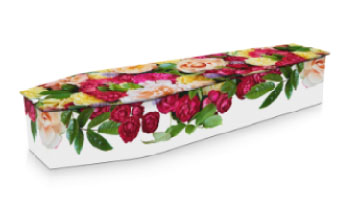Humans have been making their final goodbyes in meaningful celebrations for millennia. The Great Pyramid of Gisa was built for that purpose over 4,000 years ago. Mungo Man’s ceremonially ochred bones – dated at well over 40,000 years old – are the oldest burial ritual currently known.
Acknowledging and paying respect to the final physical presence of a lost loved one has been a fundamental part of saying farewell and creating closure from time immemorial.
It acknowledges that one person is leaving while the rest of us are staying behind to keep on with living.
A funeral without a coffin is just a memorial service – it fails to provide the closure of an authentic life celebration ceremony with a physical presence that arrives and then journeys on without us.
The heart of the celebration
Putting the coffin at the heart of the ceremony puts a strong focus on the person being farewelled.
The coffin is a powerful symbol through the celebration, connecting you with them as you remember the life they lived and thank them for the difference they made. As the coffin leaves and you say your final goodbye, a true sense of closure is created. You’re staying while they’re moving on.
The choice of coffin, how it is decorated, where it is placed, how the ceremony is organized around it, and the process of leaving weave together to create a strong sense of a loving goodbye.
Personal coffin and casket choices
A coffin today is far more than a formal, traditional box. There are a wealth of choices to appropriately reflect a special person, their values and the difference they’ve made, including:
• Wicker coffins
• Sustainable timber coffins and caskets
• Culturally relevant coffins and caskets
• Plain white coffins you can write on or decorate yourself – beforehand or as part of the ceremony
• Printed coffins in sustainable timber or cardboard with standard or customized images – perhaps from your own photo collection.
Focus and surroundings
The coffin is placed front and centre of the celebration, to focus people’s thoughts and memories. Depending on the venue you’ve chosen, it could be that there’s a particularly meaningful placement – in the centre of a circle, or surrounded by treasured items full of meaning.
If you choose to honour your special person in their favourite backyard, it could be beside the BBQ they loved or amongst the roses they planted.
That final goodbye
The culmination of a Life Celebration is the send-off of the coffin. Background music for the departure, a unique transport vehicle for the trip to their final resting place, all can be made personal and authentic for a truly meaningful goodbye.
Immediate family or friends may escort the coffin from the venue to say a final personal goodbye.
While the traditional hearse is still commonly used, we’ve organized transport by motorbike sidecar, on utes and in family station wagons.
The final farewell moments might be celebrated with a, by placing individual flowers, or to the strains of a lone piper.
Have you thought about how to celebrate a life well lived?
Most people organize only one or two funerals in their life. All too often, the preparations aren’t even started until after death has occurred.
That can make things more difficult than they need to be – at a time that is beyond “difficult”.
When you shift your focus from mourning a death to celebrating a life, pre-planning becomes an act of love in which you acknowledge the values lived, the relationships formed and the differences made.
Be an exception
More than 50% of people don’t even choose a Funeral Director until after death has occurred – that really is the hard way to do things.
Would you like to explore how you could begin to create a celebration of a life well lived and the difference they’ve made? Get started here or call us today to book an obligation free consultation ph: 02 9683-5456.

